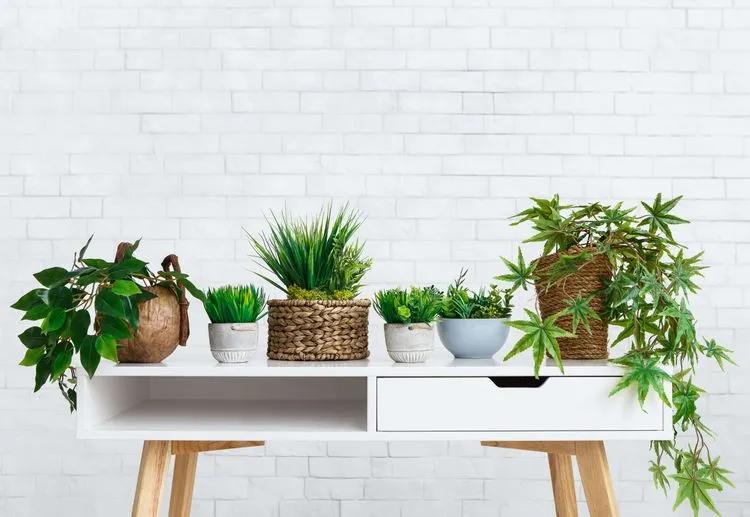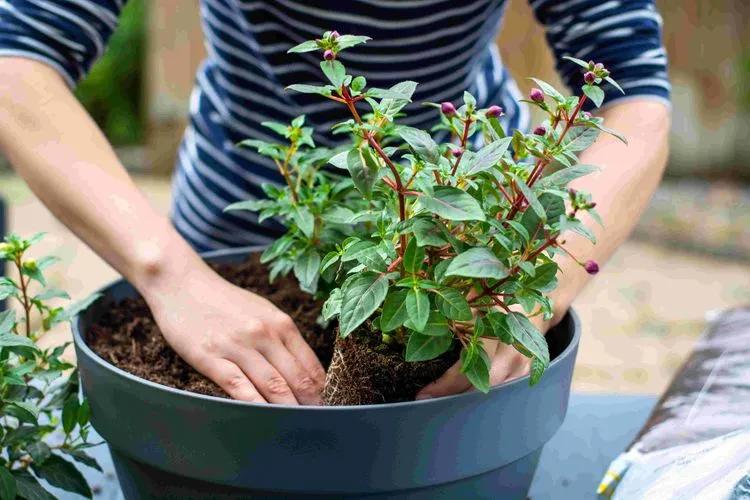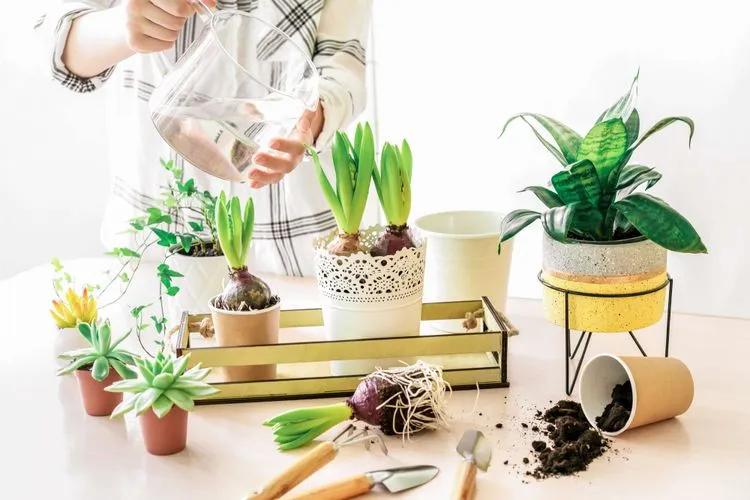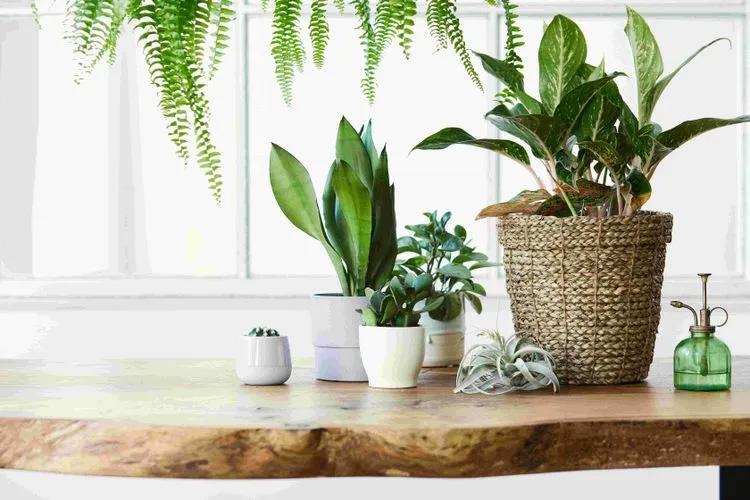Intro
 Houseplants are a living accessory for interior spaces, introducing texture and color. Your houseplants can infuse your home with warmth, soften transitions between spaces, and serve as the focal point of a room. Pairing pots, plants and the right decor enhances health and make plants a hardworking accent to your home.
Houseplants are a living accessory for interior spaces, introducing texture and color. Your houseplants can infuse your home with warmth, soften transitions between spaces, and serve as the focal point of a room. Pairing pots, plants and the right decor enhances health and make plants a hardworking accent to your home.
When it's time to repot
 Daunting though it may be, repotting is an important skill for any gardener (indoor or out) and like many things in life, simply requires gentle confidence, common sense, and a little know-how.
Most plants will need to be repotted once a year, although some slow growers might just need a topdressing (a few inches of fresh soil on top of the old) to keep them going. Springtime is the best time to repot. Plants are emerging from their winter dormancy and are hungry for fresh nutrients and more room to grow. It’s also warm and bright which means that soil will dry out quickly between waterings (which is important after repotting to avoid root rot).
If you miss spring, summer is still a good time to repot your houseplants, but avoid very hot, dry days when plants may already be stressed and have a hard time adjusting. Autumn and winter are less ideal because your plants are dormant (or going dormant), which basically means that they’re hibernating and would really rather not be disturbed. In winter, even the moisture in fresh soil can overwhelm some plants and cause root rot.
A common misconception is that a stressed plant should be repotted for a pick-me-up. In some cases such as extreme overwatering, certain pests and fungal issues, or if the plant is actually potbound (in need of fresh soil and a bigger pot) this is true, but in many instances repotting a stressed plant will only stress it further. Repotting is a big change for a plant and its delicate root system and should only be done when absolutely necessary.
If your plant been in the same container for years, it’s definitely ready for a new pot (or at least a root checkup).
Daunting though it may be, repotting is an important skill for any gardener (indoor or out) and like many things in life, simply requires gentle confidence, common sense, and a little know-how.
Most plants will need to be repotted once a year, although some slow growers might just need a topdressing (a few inches of fresh soil on top of the old) to keep them going. Springtime is the best time to repot. Plants are emerging from their winter dormancy and are hungry for fresh nutrients and more room to grow. It’s also warm and bright which means that soil will dry out quickly between waterings (which is important after repotting to avoid root rot).
If you miss spring, summer is still a good time to repot your houseplants, but avoid very hot, dry days when plants may already be stressed and have a hard time adjusting. Autumn and winter are less ideal because your plants are dormant (or going dormant), which basically means that they’re hibernating and would really rather not be disturbed. In winter, even the moisture in fresh soil can overwhelm some plants and cause root rot.
A common misconception is that a stressed plant should be repotted for a pick-me-up. In some cases such as extreme overwatering, certain pests and fungal issues, or if the plant is actually potbound (in need of fresh soil and a bigger pot) this is true, but in many instances repotting a stressed plant will only stress it further. Repotting is a big change for a plant and its delicate root system and should only be done when absolutely necessary.
If your plant been in the same container for years, it’s definitely ready for a new pot (or at least a root checkup).
Signs to look at
 Some common signs that a plant needs more room or fresh soil nutrients are:
Some common signs that a plant needs more room or fresh soil nutrients are:
- A noticeable decrease in soil level or quality (soil level has dropped over time or appears dry and hardened)
- Roots visibly growing out the bottom of the pot, top edges of the pot, or busting through the pot
- Plant dries out suspiciously fast, needing more water than it used to (or water runs right through pot, not seeming to saturate the soil)
- Plant is obviously top heavy or awkwardly big for its pot without any surface area for new growth.
How to choose a right pot
 When determining how to choose the right pot for your houseplant, a key consideration is the size of the new container relative to the old.
A common myth is that plants will grow larger if potted in a larger pot, like a goldfish in a fishbowl. This seems logical, but actually most houseplants prefer a snugger fit. Roots do not quickly fill a space when given room, but rather grow when and where they want to, usually rather slowly. When you repot into a much larger container, the roots are surrounded by soil and can’t pull the water from it fast enough, leaving it wet too long and drowning the roots. A smaller amount of soil dries out more quickly and allows more oxygen to reach the roots, which they need to survive.
Some pots have holes at the bottom and some don’t. When you’re anxious to get your plant into something practical that looks good, these details can seem unnecessarily complicated but it behooves every indoor gardener to learn how drainage works and how this might affect their preferences in pottery.
Simply put, a pot with drainage (holes) is almost always the better option for plant health than a pot with no drainage (no holes). That’s not to say you can’t pick a pot without drainage, but if you’re a beginner puzzling over how to choose the right pot, drainage holes will definitely simplify your care regimen.
Covering a drainage hole with a piece of burlap or cheesecloth helps keep soil in, without inhibiting drainage.
A pot with drainage allows excess water to flow through the roots and out the bottom instead of settling in the bottom of the pot where it can quickly cause fungal issues or root rot. We prefer to call these pots without drainage cachepots and recommend using them decoratively by resting a plastic nursery pot (with drainage) inside. If the sight of plastic bothers you, you can use Spanish or sphagnum moss to cover any gaps or edges. Most nurseries carry plastic liners if you want to protect the interior of your pot or basket.
That having been said, some people really prefer the option of a pot without drainage and have a knack for knowing when and how much to water. Tending to plants is a highly personal endeavor and is ultimately about cultivating joy in our lives, so you do you. If you want to pot directly into a cachepot, some plants are better candidates than others for these situations. Cacti, succulents, and some semi-succulent tropical plants such as Sansevierias (snake plants) are good candidates because they need water infrequently, which lessens the risk of making an error and overwatering.
While the differences between pot materials are largely aesthetic, there are a few distinctions that can affect the health of your plants.
First of all, decide whether your pot is going to live indoors or outdoors. Stone or concrete is a good choice for outdoor pots that will be exposed to the elements. They tend to be a bit heavier so it’s a good idea to place them where they won’t need to move. Indoor pots tend to be more lightweight so they can be easily moved according to your style.
When determining how to choose the right pot for your houseplant, a key consideration is the size of the new container relative to the old.
A common myth is that plants will grow larger if potted in a larger pot, like a goldfish in a fishbowl. This seems logical, but actually most houseplants prefer a snugger fit. Roots do not quickly fill a space when given room, but rather grow when and where they want to, usually rather slowly. When you repot into a much larger container, the roots are surrounded by soil and can’t pull the water from it fast enough, leaving it wet too long and drowning the roots. A smaller amount of soil dries out more quickly and allows more oxygen to reach the roots, which they need to survive.
Some pots have holes at the bottom and some don’t. When you’re anxious to get your plant into something practical that looks good, these details can seem unnecessarily complicated but it behooves every indoor gardener to learn how drainage works and how this might affect their preferences in pottery.
Simply put, a pot with drainage (holes) is almost always the better option for plant health than a pot with no drainage (no holes). That’s not to say you can’t pick a pot without drainage, but if you’re a beginner puzzling over how to choose the right pot, drainage holes will definitely simplify your care regimen.
Covering a drainage hole with a piece of burlap or cheesecloth helps keep soil in, without inhibiting drainage.
A pot with drainage allows excess water to flow through the roots and out the bottom instead of settling in the bottom of the pot where it can quickly cause fungal issues or root rot. We prefer to call these pots without drainage cachepots and recommend using them decoratively by resting a plastic nursery pot (with drainage) inside. If the sight of plastic bothers you, you can use Spanish or sphagnum moss to cover any gaps or edges. Most nurseries carry plastic liners if you want to protect the interior of your pot or basket.
That having been said, some people really prefer the option of a pot without drainage and have a knack for knowing when and how much to water. Tending to plants is a highly personal endeavor and is ultimately about cultivating joy in our lives, so you do you. If you want to pot directly into a cachepot, some plants are better candidates than others for these situations. Cacti, succulents, and some semi-succulent tropical plants such as Sansevierias (snake plants) are good candidates because they need water infrequently, which lessens the risk of making an error and overwatering.
While the differences between pot materials are largely aesthetic, there are a few distinctions that can affect the health of your plants.
First of all, decide whether your pot is going to live indoors or outdoors. Stone or concrete is a good choice for outdoor pots that will be exposed to the elements. They tend to be a bit heavier so it’s a good idea to place them where they won’t need to move. Indoor pots tend to be more lightweight so they can be easily moved according to your style.
Types of pots
 Plastic pots: These tend to be lightweight and low-cost, and they're available in many different colors. Plastic pots are better for indoor plants, as certain types of plastic (particularly black plastic) absorb summer heat and can cook your plant's roots. Be wary of very thin plastic; although plastic does not biodegrade, it does photodegrade, which means strong sunlight can eventually cause the pot to fall apart.
Terracotta pots: Made from red clay, these classic pots are the default for container gardening. The porous terracotta material absorbs water from the soil and then dries out, so either pair these plants with drought-tolerant species (like succulents and rosemary), or plan to do a lot of watering.
Glazed ceramic pots: These pots are sturdy, heavy, and can be glazed in a wide array of colors. Almost any plant will do well in a glazed ceramic pot. The two drawbacks are higher prices and a tendency to crack in freezing temperatures.
Hanging baskets: Consider this option for small plants, especially succulents. Hanging baskets give plants plenty of drainage, so don’t place anything below them that you don’t want getting wet.
Not only does a container’s size affect how well a plant grows, the container’s shape does too.
Round, square and rectangular: Medium to large round, square and rectangular containers with deep soil reservoirs (30 to 90 centimetres, depending on the plant type) are good options for flowering perennials, shrubs and small trees. Use larger containers for planting combinations of multiple plants so each plant has room to grow.
Shallow: Low bowls with less than 15 centimetres of soil are perfect for growing small succulents such as stonecrop (Sedum spp.) and hens and chicks (Sempervivum spp.).Planting stands can raise low containers a little closer to eye level. Shallow containers also work well as toppers for outdoor side tables and dining tables.
Vase-shaped: Containers that flare out at the top are good options for mixed combinations of annuals, flowering perennials and an evergreen shrub or small tree. The wide opening gives plenty of space to put together a combination of plants. Select the depth of the container based on which plant types you’d like to include.
Urn-shaped: Classical-style urns (wide at the bottom with a tight neck and wider opening) are good vessels for annuals and easily removed perennials. Keep in mind that if you plant anything that is deep-rooting, once a root ball forms below the neck of the urn, it can be tough to remove the plant.
Tall and upright: Tall, skinny containers can help elevate small plants, giving them more visual impact. Be careful about pairing a shallow-rooting plant such as a succulent with a tall container (anything over 60 centimetres) filled with soil. It’s easy to overwater and have wet soil collect at the base of the pot beyond the plant roots.
Plastic pots: These tend to be lightweight and low-cost, and they're available in many different colors. Plastic pots are better for indoor plants, as certain types of plastic (particularly black plastic) absorb summer heat and can cook your plant's roots. Be wary of very thin plastic; although plastic does not biodegrade, it does photodegrade, which means strong sunlight can eventually cause the pot to fall apart.
Terracotta pots: Made from red clay, these classic pots are the default for container gardening. The porous terracotta material absorbs water from the soil and then dries out, so either pair these plants with drought-tolerant species (like succulents and rosemary), or plan to do a lot of watering.
Glazed ceramic pots: These pots are sturdy, heavy, and can be glazed in a wide array of colors. Almost any plant will do well in a glazed ceramic pot. The two drawbacks are higher prices and a tendency to crack in freezing temperatures.
Hanging baskets: Consider this option for small plants, especially succulents. Hanging baskets give plants plenty of drainage, so don’t place anything below them that you don’t want getting wet.
Not only does a container’s size affect how well a plant grows, the container’s shape does too.
Round, square and rectangular: Medium to large round, square and rectangular containers with deep soil reservoirs (30 to 90 centimetres, depending on the plant type) are good options for flowering perennials, shrubs and small trees. Use larger containers for planting combinations of multiple plants so each plant has room to grow.
Shallow: Low bowls with less than 15 centimetres of soil are perfect for growing small succulents such as stonecrop (Sedum spp.) and hens and chicks (Sempervivum spp.).Planting stands can raise low containers a little closer to eye level. Shallow containers also work well as toppers for outdoor side tables and dining tables.
Vase-shaped: Containers that flare out at the top are good options for mixed combinations of annuals, flowering perennials and an evergreen shrub or small tree. The wide opening gives plenty of space to put together a combination of plants. Select the depth of the container based on which plant types you’d like to include.
Urn-shaped: Classical-style urns (wide at the bottom with a tight neck and wider opening) are good vessels for annuals and easily removed perennials. Keep in mind that if you plant anything that is deep-rooting, once a root ball forms below the neck of the urn, it can be tough to remove the plant.
Tall and upright: Tall, skinny containers can help elevate small plants, giving them more visual impact. Be careful about pairing a shallow-rooting plant such as a succulent with a tall container (anything over 60 centimetres) filled with soil. It’s easy to overwater and have wet soil collect at the base of the pot beyond the plant roots.
Closing thoughts
 When you’re choosing a container based on a plant, don’t rely on the plant’s initial size when estimating the size of container you will need. Instead, look up the mature size of the plant (often found on the back of the plant label) and which category it falls into (succulent, annual, perennial, shrub or tree). Be sure to choose a container that allows enough room for the plant to grow and a soil depth that will provide plenty of root space.
It’s best to give each medium- or large-size edible plant its own container — possibly tucking herbs or pollinator-friendly plants like marigolds around the base if there’s excess room. Lettuces and smaller plants like radishes and strawberries can be planted with multiple plants per container.
Container-grown edibles are big ‘feeders’, meaning they take a lot of soil nutrients to grow quickly and produce well. Fertilise with a well-balanced organic fertiliser according to package instructions.
Picking a pot for your plant is like picking a dress for a person. Some people look great in bright colours, others only look good in black. Different dresses are made for differently shaped people; some scarves colours look particularly good on people with dark hair or a darker complexion. The same goes with plants; not every pot looks good on every plant. Picking the right pot for your plant may be an easy task once you learn the basic rules of thumb; size, materials and drainage requirements.
When you’re choosing a container based on a plant, don’t rely on the plant’s initial size when estimating the size of container you will need. Instead, look up the mature size of the plant (often found on the back of the plant label) and which category it falls into (succulent, annual, perennial, shrub or tree). Be sure to choose a container that allows enough room for the plant to grow and a soil depth that will provide plenty of root space.
It’s best to give each medium- or large-size edible plant its own container — possibly tucking herbs or pollinator-friendly plants like marigolds around the base if there’s excess room. Lettuces and smaller plants like radishes and strawberries can be planted with multiple plants per container.
Container-grown edibles are big ‘feeders’, meaning they take a lot of soil nutrients to grow quickly and produce well. Fertilise with a well-balanced organic fertiliser according to package instructions.
Picking a pot for your plant is like picking a dress for a person. Some people look great in bright colours, others only look good in black. Different dresses are made for differently shaped people; some scarves colours look particularly good on people with dark hair or a darker complexion. The same goes with plants; not every pot looks good on every plant. Picking the right pot for your plant may be an easy task once you learn the basic rules of thumb; size, materials and drainage requirements.
